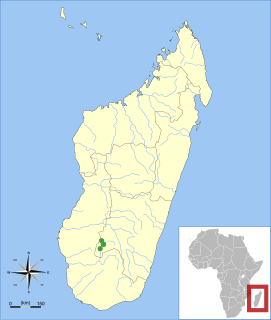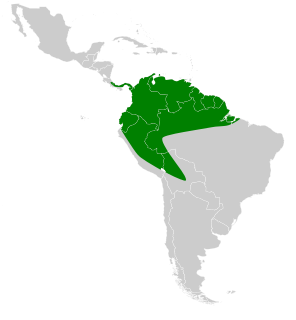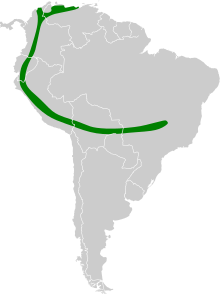
The big brown bat is a species of vesper bat distributed widely throughout North America, the Caribbean, and the northern portion of South America. It was first described as a species in 1796. Compared to other microbats, the big brown bat is relatively large, weighing 15–26 g (0.53–0.92 oz) and possessing a wingspan of 32.5–35 cm (12.8–13.8 in).

The serotine bat, also known as the common serotine bat, big brown bat, or silky bat, is a fairly large Eurasian bat with quite large ears. It has a wingspan of around 37 cm (15 in) and often hunts in woodland. It sometimes roosts in buildings, hanging upside down, in small groups or individually. The name serotine is derived from the Latin serotinus, which means 'evening', while the generic name derives from Greek ἔπιεν and οίκος, which means 'house flyer'.

The Brazilian brown bat, is a bat species from South and Central America.

The diminutive serotine is a bat species]] found in Argentina, Colombia, Brazil, Paraguay, Uruguay, and Venezuela.

The northern bat is the most abundant species of bat in northern Eurasia. It is found from England to Hokkaidō and south to northern India. It is closely related to the serotine bat.

Kobayashi's bat is a species of bat. An adult Kobayashi's bat has a body length of 6.0–6.3 centimetres (2.4–2.5 in), a tail length of 4.6–4.8 centimetres (1.8–1.9 in), and a wing length of 4.5–4.7 centimetres (1.8–1.9 in). The species is found only on the Korean Peninsula; it has been suggested that it may be a local form of Eptesicus bottae, Botta's serotine.

Eptesicus is a genus of bats, commonly called house bats or serotine bats, in the family Vespertilionidae. The genus name is likely derived from the Greek words ptetikos 'able to fly' or petomai 'house flier', although this is not certain.
Bobrinski's serotine is a species of vesper bat. It can be found in Iran and Kazakhstan.
Botta's serotine is a species of vesper bat, one of 25 in the genus Eptesicus. It is found in rocky areas and temperate desert.

The Surat helmeted bat is a species of vesper bat. It ranges from Thailand and Laos west to Nepal.
The Guadeloupe big brown bat is a species of vesper bat. It is found only on the island of Guadeloupe. It is one of the eleven species of bat found on Guadeloupe, and one of three that are endemic.
The yellow-lipped cave bat is a vespertilionid bat which only occurs in the Kimberley region of northwest Australia. The bat was first captured at Tunnel Creek in 1958 and a description published nearly twenty years later. Aside from observations of their physical characteristics, a preference for caves, and hunting insects over streams, little is known of the species.
Abrothrix andina, also known as the Andean Altiplano mouse or Andean akodont, is a species of rodent in the genus Abrothrix of family Cricetidae. It is found in the Altiplano habitat of the Andes from central Peru through Bolivia, south to Argentina and Chile.
Oligoryzomys andinus, also known as the Andean colilargo or Andean pygmy rice rat, is a species of rodent in genus Oligoryzomys of family Cricetidae. It is found in the Andes of southern Peru and western Bolivia, but may in fact include more than one species. Its karyotype has 2n = 60 and FNa = 70.

Taddei's serotine is a species of medium-sized bat belonging to the family Vespertilionidae. It is restricted to the Atlantic Forest of southern Brazil.

The harmless serotine is a species of vesper bat. It has a restricted range in western Ecuador and northwestern Peru. An insectivorous species, it is a resident of tropical dry forest habitat, and is threatened by deforestation.

The Isalo serotine is a vespertilionid bat of Madagascar in the genus Laephotis. It is known only from the vicinity of the Isalo National Park in the southwestern part of the island, where it has been caught in riverine habitats. After the first specimen was caught in 1967, it was described as a subspecies of Eptesicus somalicus in 1995. After four more specimens were collected in 2002 and 2003, it was recognized as a separate species. Because of its small distribution and the threat of habitat destruction, it is considered "vulnerable" in the IUCN Red List.

The Chiriquinan serotine is a species of house bat.

The meridional serotine is a species of bat native to the Iberian Peninsula, Morocco, Algeria, Tunisia and Libya.
The Anatolian serotine bat is a species of bat found in the Middle-East, Cyprus and Rhodes Island, Greece.













